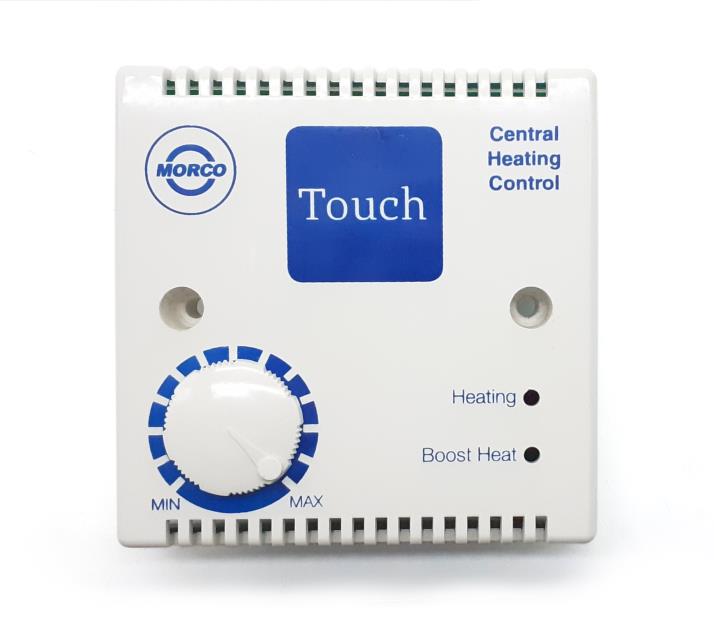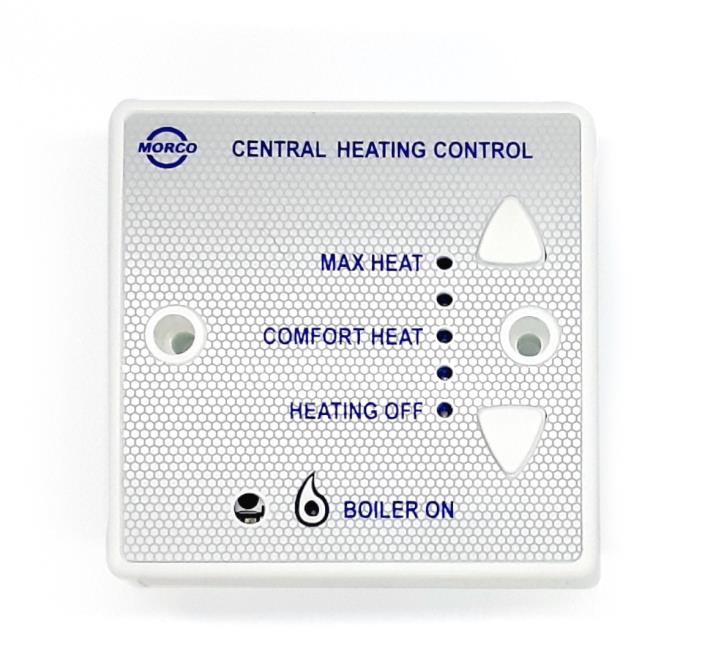

Both of the above photographed thermostats are Morco Boost Thermostats. The one on the left is the older style, the one on the right is the current model.
Rental Units
This product was designed to reduce the gas consumption of the central heating system in holiday homes that started their lives as rental units. It works by limiting the time for which a central heating system will work continuously and by limiting the maximum temperature that the heating system will create within the home. The control offered by the system was deemed necessary due to the habit of rental customers turning the heating to maximum, the time clock to 24/7 and then regulating the temperature by opening windows. The gas supply to the rented home is usually paid for by the park and they therefore had a vested interest in limiting the amount of gas used.
Privately Owned Holiday Homes
The product was rarely installed in holiday homes intended for private ownership but in recent years a number of homes from rental/hire fleets with these thermostats fitted have been sold on to private owners. Private owners pay for their own gas bottles and are therefore more likely to control the temperature in the home and the time for which the heating is on. This makes the energy saving function of the boost thermostat potentially redundant and its method of operation may irritate private home owners.
Some holiday homes may also have key switches fitted which have an ‘owner’s’ setting and a ‘letting’ mode. Depending on which of the below options you choose, this may need to be taken into consideration.
There are three options open to private owners who find the boost thermostat installed in their home:
- The thermostat can be easily disconnected/removed and the heating can then be controlled by the time clock and the thermostatic radiator valves, TRVs (if fitted). This is best carried out by an electrician as some combi boilers are switched by 230VAC mains electricity. The two switch wires that enter the bottom of the boiler need to be removed and replaced by a small ‘loop’ wire.
- A replacement thermostat can be fitted in the same place as the boost thermostat and can utilise the wiring between the thermostat and the boiler (see the accompanying article for Thermostats Programmers and TRVs). Again, it is best to ask a qualified electrician to carry out this work.
- Leave the thermostat installed and use it as it was intended.
For the older style thermostats with the ‘touch’ pad:
- If you are too cold, press the ‘touch’ pad on the control box
- The thermostat will allow a temperature of 23 °C to be maintained for 2 hours.
- After the 2 hours a temperature of 18 °C will be maintained for 10 hours.
- If the pad is touched during the 10-hour period the system will allow another 2 hours at 23 °C followed by 10 hours at 18 °C.
- If the pad is not touched during the 10 hours a target temperature of 5°C is applied indefinitely (frost stat). Pressing the pad during this period will target 23 °C as before
- If you subsequently become too hot then turn the dial on the control anti-clockwise
For the newer style thermostats with the up and down buttons:
- The lights on the control box indicate which temperature setting is selected:
- 23 °C (max heat)
- 21 °C
- 19 °C (comfort heat)
- 18 °C
- 5 °C (heating off – frost stat)
- If you are too cold or too hot, press the up or down button on the control box up to four times, depending on which of the above temperatures is required
- For the highest three temperatures, the thermostat will maintain the selected setting for 2 hours
- After the 2 hours a temperature of 18 °C will be maintained for 10 hours
- If the up button is pressed during the 10-hour period the system will allow another 2 hours at the newly selected temperature
- If the button is not pressed during the 10 hours a target temperature of 5°C is applied indefinitely (frost stat)
- Please note that some earlier models of this thermostat do not have the additional temperatures and function in a similar way to the older ‘touch’ stat style with the up and down buttons replacing the ‘touch’ pad and the dial respectively
For the system to work in this way with either thermostat the time clock on the boiler must be set to ‘permanently on’ (see below) and the boiler control knobs in the ‘on’ position, calling for heat.
Time Clock
|
|
|
|
GB24 Models |
FEB24 Models |
Download a copy of this help article



